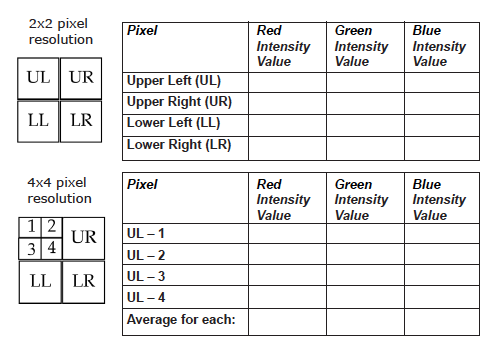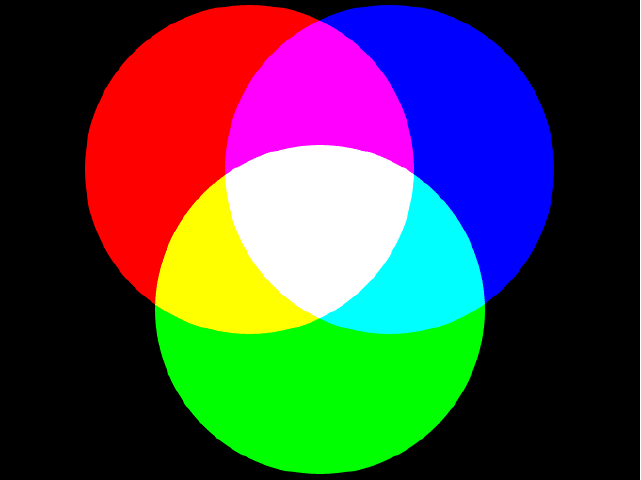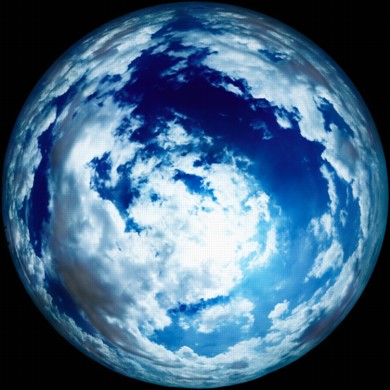DEW1.6. Resolution and Pixel Color
The number of pixels in an image tells you the picture’s resolution. More pixels means a higher resolution, allowing you to distinguish more details in the picture.
The Pixels button of the software DigitalImageBasics can increase and decrease the resolution of the image, so that you can see how many pixels are necessary to recognize the picture’s subject. When you open an image, it will be at the lowest resolution: 2×2=4 pixels. Increase the number of pixels until you can make out what the picture is. Record the resolution needed to recognize the mystery pictures.
Use the program DigitalImageBasics with the Pixels button activated to fill out the chart on the next page and answer these questions:
Question DEW1.5.1.
How does the resolution of an image affect what you can see? Why would you need more pixels to identify an image?
Question DEW1.5.2.
When could you identify an image with large pixels? How does resolution affect interpreting satellite images?
Pixel Count Chart
| Mystery Picture # | At what resolution can you recognize the picture subject? | What is the subject of this picture? |
Color of a Pixel
The word pixel comes from the phrase “picture element.” Each pixel displays the color of a tiny region of the image, and that color is the average color for the entire region. You can use the following tables to keep track of the red, green, and blue intensities of a large pixel and the smaller pixels that define the same region.


- Open a mystery picture of your choice in DigitalImageBasics with the Pixels button active. With the resolution at the minimum, 2×2=4, show the pixel borders for 2×2. Move the cursor over each pixel and write down the color intensity values (%) shown in the lower, left area of DigitalImageBasics window.
- Increase the resolution of the picture to 4×4=16. This time write down the color intensity values for the four pixels that cover the same region as the Upper Left pixel from the 2×2 resolution. In the last row, write the average value of the column.
Question DEW1.5.3.
Compare the averages from the second chart to the values for the Upper Left pixel from the first chart.How are they alike? What do you expect would be average intensity values for the pixels in this same region if the resolution is 8×8?
Switching Colors

When your computer displays an image, it takes the red intensity values from the image file and makes the red dots shine by those amounts. The DigitalImageBasics software program allows you to change which set of colors in the image file shine as which colors on the computer display—in other words change it so the red intensity values from the image file make the green dots or blue dots on the screen shine instead.
Using DigitalImageBasics software with the Colors button active, open the picture Color Circles 1. Notice that the initial settings of the program have the same colors for “Color Measured by Camera” and “Displayed Color” (which is the color display on the computer monitor).
Color Circles 1 has red, green, and blue.

Question DEW1.5.4.
Describe the colors you see in Color Circles 1. What color is the circle at the top? On the left? On the right? What other colors do you see in the picture?
Question DEW1.5.5.
Change the combinations of “Color Measured by Camera” and “Displayed Color.” What happens to the circle at the top?
Do the same with Color Circles 2.
Color Circles 2 has cyan, magenta, and yellow.
CHALLENGE: 1 Circle from 3
Can you make the picture have only one yellow circle?

CHALLENGE: A Cat’s True Colors
Change the colors of this picture to find the cat’s true colors.
There is one solution to this challenge.
Download the image of the cat on the right and view in the “Colors” window of the DigitalImageBasics software.
To download the image, either right-click or click and hold on the image. A pop-up menu will have the option to ‘Save Image As…’, which allows you to save the image on your computer.
You may do this to download most images available on the Internet.
Seeing One Color

Open the picture Sample: RGB Color Space. This is a picture where the edges of a cube span all the values of RGB colors. Notice how the colors in this picture are arranged. Imagine what things would look like if your eyes could only see one color.
Question DEW1.5.6.
What would this picture look like if we were blind to ALL colors except red—that is if we could see ONLY red light? How would the image look different in red than with all colors? Move your mouse over the picture to see the red intensity values of pixels throughout the image.
Question DEW1.5.7.
Change the view of this picture so that you can only see the red intensity values of the image file. To do this, set all three “Color Measured by Camera” choices to ‘Red’. What areas look bright in red light? Which areas look dark? You can also try settng the Blue and Green values to “None”.
Question DEW1.5.8.
Now view the picture with only the blue light. How does the picture look different? What details can you see better in the blue light? What is visible in the red light?
Question DEW1.5.9.
When all of the computer display colors show the red picture color, why does the image appear black and white? If your eyes were only able to see red, do you think that is what the world would look like?
Colors of the Sky

Open the picture AllSky.jpg. This is a picture of the sky using a camera with a fish-eye lens, which allows most of the sky to be seen at once. This picture is courtesy of Chuck Wilcox at the Museum of Science, Boston, Massachusetts.
Now that you have learned so much about color and light, get to know the colors in this picture. Move your mouse around the image and notice the color intensity values throughout the picture. Change which picture colors are seen in the computer display colors.
Question DEW1.5.10.
Which of the three-color components (red, green, or blue) is dominant in the sky? Which color contributes the least intensity to the sky? See the contribution of a color by setting all of the computer display colors to a single picture color.
Question DEW1.5.11.
If the sky is blue because of tiny atmospheric particles scattering blue light, why is the Sun yellow? Hint: this is a good time to take a look back at the Tri-Color Reference Chart that you created in Part 1.
Question DEW1.5.12.
If the Sun appears to be yellow, why do clouds appear so white in the image? If you were riding on a satellite thousands of miles above the Earth, what would be the color of the “sky” (or outer space) and what would be the color of sunlight?
Open the picture sunset.jpg. This is a picture of the Sun setting over the ocean. Here the sky is yellow and orange while the clouds are dark. Use the ColorPicture program to get to know the colors in this picture.
Question DEW1.5.13.
Why is the color of the sky different at sunset from the middle of the day? What about the clouds and the Sun?
Question DEW1.5.14.
What color is the dominant color of the water? Where is the blue in this picture?


